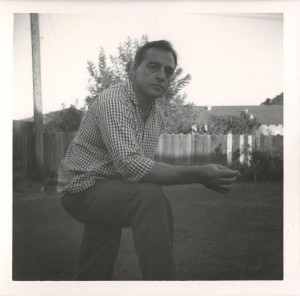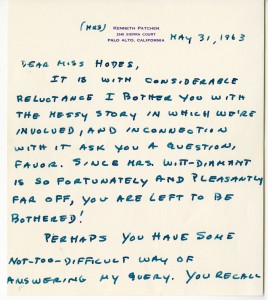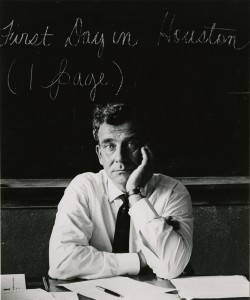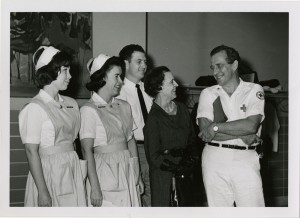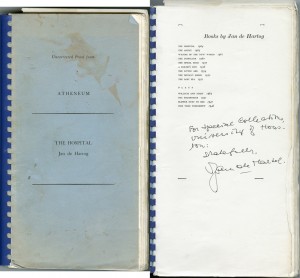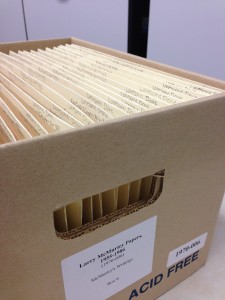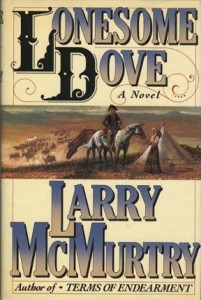
Do you watch Mad Men? A lot of us here in Special Collections do, and we noticed that on last night’s episode (no spoilers here, we promise) the book that Don Draper is reading on the airplane is Larry McMurtry’s The Last Picture Show. Not only do we have in our stacks a copy of that exact edition in Draper’s hands (a first printing of the Dell paperback from 1967),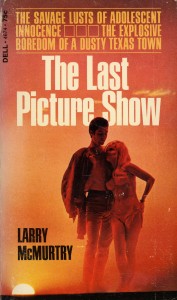 but we also have in our archives Larry McMurtry’s first draft of the typescript of the novel, complete with handwritten notes, a character list, an outline, and some discarded pages. Researchers and fans of McMurtry’s work can visit us here to follow the evolution of this novel from first draft to second draft to publisher’s copy, and compare these to the final published piece. (We highly recommend the 1971 film version of the book as well, available in the Anderson library’s DVD collection.)
but we also have in our archives Larry McMurtry’s first draft of the typescript of the novel, complete with handwritten notes, a character list, an outline, and some discarded pages. Researchers and fans of McMurtry’s work can visit us here to follow the evolution of this novel from first draft to second draft to publisher’s copy, and compare these to the final published piece. (We highly recommend the 1971 film version of the book as well, available in the Anderson library’s DVD collection.)
So, what does it mean for Don Draper to be reading The Last Picture Show? Well, we have some ideas, but don’t want to give away any spoilers in case you haven’t watched the episode yet.
University of Houston Special Collections recently acquired a new addition for our Kenneth Patchen Collection. This nine page letter from the poet’s wife, Miriam Patchen, to Ida Hodes is dated May 31, 1963 and includes Ms. Hodes’s response. The letter highlights the physical and financial struggles of both Kenneth and Miriam and will be included alongside other correspondence in the collection.
The arc of Kenneth Patchen’s life and artistic career reads like an outsider artist archetype. Born in Niles, Ohio in 1911, his father was a steelworker in the heart of the nation’s thriving foundry. A ravenous reader and writer at a young age, Patchen sidestepped his blue-collar inevitability to forge and enter an artistic world. Earning a scholarship to Alexander Meiklejohn’s Experimental College at the University of Wisconsin in Madison, Patchen would have his first taste of publishing success (a poem in the New York Times, no less) and cut his formal education short, traveling around the country, writing, and working odd jobs for a number of years. It was during this time he would meet Miriam Oikemus, with whom he would spend his life as she worked beside him and cared for him while he battled crippling pain from a back injury he suffered in his twenties.
Before there was the stereotype of the beatnik poet capped by a black beret, reading poetry in a coffeehouse while the lurid notes of jazz trip through the smoky air, Kenneth Patchen was appearing in nightclubs along the West Coast, reading on college campuses, and recording with jazz ensembles. Before the Beat Generation’s seething and bubbling of the 1950s threatened to explode into the counterculture of the 1960s, there was the small, devoted following of a poet named Patchen, who had a habit of mixing his media. His poetry spoke too boldly to simply be confined to the page as he experimented with poetry-jazz (the mixture of the language of poetry fused with the improvisational medium of music) and the picture poem (where the words are given opportunity to play off the visuals of the paint).
Patchen struggled with pain, however, and the financial impact was pronounced. Fellowships and income from publishing no doubt helped, but limited ability to tour, lecture, or give readings kept money tight. A surgery fund established by fellow poets (including such luminaries as T.S. Eliot, e.e. cummings, and W.H. Auden) helped and, with proper medical care, Patchen seemed to be headed towards a better quality of life. It was the 1959 surgical debacle however, resulting in severe injury to his back, that left Patchen bedridden for the majority of the last 13 years of his life. By the time he passed away in 1972, Patchen had published 43 books of poetry, prose, and picture poems, though his creative successes were no doubt cut short by the physical pain with which he struggled. The balancing of finances as well as the day to day drudgery and heartache proved difficult for both Kenneth and Miriam as we see highlighted in this new acquisition.
In piecing together a medical malpractice suit related to his injury, Miriam’s frustration is evident as she attempts to placate their attorneys and place a price tag on her husband’s worth. Miriam writes to Ms. Hodes, a former contact at the Poetry Center, “Apparently, the only crime is to deprive a wage-earner of a salary. That’s all we get from the law. ‘How much have you lost?’ When? How? My apologies–I’m nearly hysterical with the weight of these 4 years.”
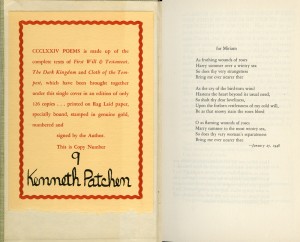
from CCCLXXIV Poems, author inscription alongside customary dedication to Miriam
Kenneth Patchen would pass away in 1972 while Miriam Patchen, to whom Kenneth would dedicate all of his works, passed away in 2000.
A number of Patchen’s works are available in a variety of media in Special Collections. If you see something of interest, please let us know and we’ll set it aside for your visit. Of course, no trip would be complete without a peek into Patchen’s papers, a collection including materials related to his diverse creative works and their promotion as well as personal correspondence and photographs.
Jan de Hartog (1914-2002) was born in Haarlem, Netherlands on this day in 1914 and, while he passed away from us nearly eleven years ago, we would like to offer our warmest birthday wishes here at the University of Houston Special Collections.
A prolific novelist and playwright, de Hartog may best be known for his play “The Fourposter” (winning the Tony for Best Play in 1952), his historical novel The Peaceable Kingdom: An American Saga, but his connection with Houston will be forever cemented with his non-fiction memoir The Hospital, a work that helped transform healthcare in Houston.
Having recently moved to the United States, Jan began the work of his residency at the University of Houston while Marjorie de Hartog began volunteering at the old Jefferson Davis County Hospital. Realizing the enormity of the hospital’s challenge as it tried in vain to serve those with nowhere else to turn, she shared with her husband her exasperation over the demand that seemed to dwarf the resources. This became the impetus for the writing and publication of The Hospital. The book, giving voice to the frustrations of some of the city’s most vulnerable and needy, certainly had a national impact, but its influence on local involvement in healthcare policy and funding in Houston was immediate and lasting. As a result, Jan de Hartog’s connection to the city would be permanent. He passed away in Houston in 2002 at the age of 88.
Here in Special Collections we are happy to have the papers of Jan de Hartog available for study. These papers include correspondence, press, and materials directly related to the writing and publication of The Hospital as well as the reaction and support of the community following its publication. While this transformative work is sadly out of print, it is available for checkout in the M.D. Anderson Library (among others) and we are also pleased to offer for study a publisher’s proof copy of The Hospital inscribed by the author.
We invite you to celebrate the legacy of Jan de Hartog. Take a look at the detailed finding aid outlining the materials in the collection, take a look at our catalog of his works, and stop by and wish him a happy birthday (belated or not) when you have the time.
The University of Houston Special Collections, home of the Larry McMurtry Papers, was pleased to see that Amazon.com has named McMurtry’s Lonesome Dove Texas’ top love story. Amazon writes, “Part love story, part adventure, this Pulitzer Prize winner is as ambitious and mythic as the Lone Star State itself.” Indeed, Lonesome Dove is a brilliant novel centering around the fictional border town of Lonesome Dove, where former Texas Rangers endeavor to drive cattle north into Montana.
The McMurtry Papers include a plethora of material documenting McMurtry’s writing, including notes, typescript drafts, and copyedited typescripts. If you’d like to take a look at the original material that lead to Texas’ top love story, come see us in Special Collections!

Photograph by Jerry Bauer
The finding aid for the Donald Barthelme Literary Papers is now available on the TARO website. Special Collections acquired the collection from Marion Barthelme in 2002.
Donald Barthelme grew up in Houston, Texas, and attended the University of Houston as an undergraduate. After moving to New York City in 1962 he began regularly contributing short stories to the New Yorker, becoming well-known for his use of untraditional structures and his sense of the absurd. Barthelme would go on to publish numerous collected works, four novels, and a book for children. In 1979 he joined the faculty of the UH Creative Writing Program in Houston, eventually becoming Director, a position he held until his death in 1989. Barthelme’s Sixty Stories is considered a classic of contemporary American literature.
The Barthelme Papers include typescript drafts, galley proofs, and page proofs of Donald Barthelme’s novels, collected works, short stories, and other writings, plus collages and collage stories created by Barthelme. The collection also includes letters and cards from Barthelme’s writing friends and colleagues, and about a dozen photographs of the author.
